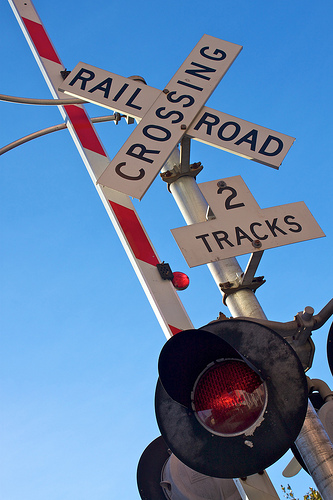Pedestrians or trespassers? Railroad fatalities skyrocket
New data released by the federal government tells an unfortunate story about railroad fatalities: Specifically, the number of pedestrians struck and killed by trains throughout the country has increased by 26 percent over the first five months of this year. Pedestrian railroad deaths climbed to 199 in that timeframe, a rise from 158 pedestrians killed during the same period in 2012. Train-collision injuries totaled 356 since May, an uptick since the 344 recorded last year. The trend has been on the upswing, however: Last year, reports the St. Louis Post-Dispatch, pedestrian railroad deaths topped 7.5 percent, although the total U.S. railroad fatalities count fell by 16.5 percent.

The St. Louis Post-Dispatch reports that 26% more pedestrians have been killed by trains in the first five months of 2012 compared to last year. Something’s not working. Image from Adam Tinworth.
Part of the issue is that the FRA considers pedestrians to be trespassers — in fact, those walking on the tracks, trestles, railroad yards and equipment may be subject to, in addition to danger, fines and arrest. Reports the Post-Dispatch, “People walking on the nation’s railroad tracks are considered trespassers since the nation’s railroad network is private property. But railroad tracks cut through dense neighborhoods and provide often-used shortcuts. Every year since 1997, more people have died walking on railroad tracks than in vehicles struck by trains at railroad crossings. The trend seems to be continuing.”
Tracks provide an easier path through parts of town that can be otherwise difficult to access. But lawmakers are often unaware of this.
According to Streetsblog, “[such attitudes] castigate the dead for being ‘dumb’ and playing with fire. But considering that rail tracks often bisect cities and even neighborhoods, dividing people from services and other community amenities, it’s not fair to treat all illegal crossings as irresponsible trespasses.”
Rather than treat pedestrians as trespassers, focus might instead be placed on studying which parts of the railroad tracks people are crossing en masse, in order to build alternative routes.
“That’s how it went in Encinitas, California, where beachgoers lugging surfboards regularly crossed train tracks to reach the Swamis surfing spot,” reported Streetsblog. “More than 50 trains a day went by, making the crossing a dangerous undertaking, but the closest legal crosswalk was more than a mile away. Rather than reprimand the ‘trespassers,’ however, the city did something far more productive: build a grade-separated walkway.” Solutions like this are intuitive and safe ones.
Pedestrians who live or work near railroad tracks can take the following precautions, according to Operation Lifesaver (which, incidentally, is partnered with the FRA and with Amtrak). See the full list for more details.
- “The only safe place to cross is at a designated public crossing with either a crossbuck, flashing red lights or a gate. If you cross at any other place, you are trespassing and can be ticketed or fined. Cross tracks only at designated pedestrian or roadway crossings.”
- “Railroad tracks, trestles, yards and equipment are private property and trespassers are subject to arrest and fine. If you are in a rail yard uninvited by a railroad official you are trespassing and subject to criminal prosecution; you could be injured or killed in a busy rail yard.”
- “It can take a mile or more to stop a train, so a locomotive engineer who suddenly sees someone on the tracks will likely be unable to stop in time. Railroad property is private property. For your safety, it is illegal to be there unless you are at a designated public crossing.”
- “Trains overhang the tracks by at least three feet in both directions; loose straps hanging from rail cars may extend even further. If you are in the right-of-way next to the tracks, you can be hit by the train.”
- “Do not cross the tracks immediately after a train passes. A second train might be blocked by the first. Trains can come from either direction. Wait until you can see clearly around the first train in both directions.”
- “Flashing red lights indicate a train is approaching from either direction. You can be fined for failure to obey these signals. Never walk around or behind lowered gates at a crossing, and do not cross the tracks until the lights have stopped flashing and it’s safe to do so.”
- “Do not attempt to hop aboard railroad equipment at any time. A slip of the foot can cost you a limb or your life.”
- “Be aware trains do not follow set schedules.”
Category: Pedestrian safety, Resources, Road safety

















